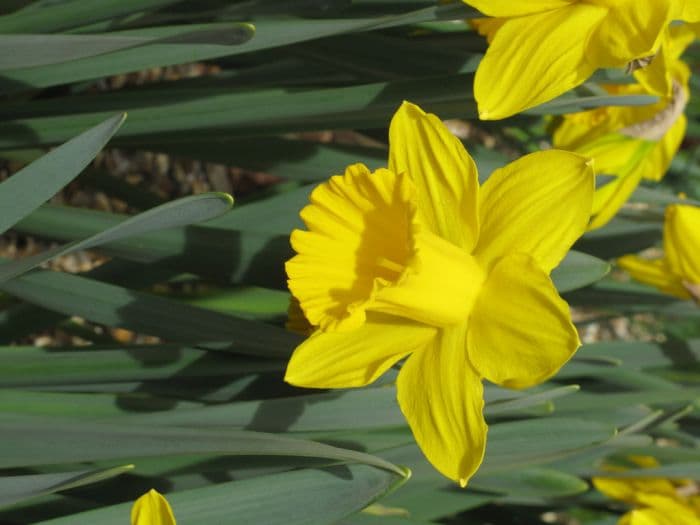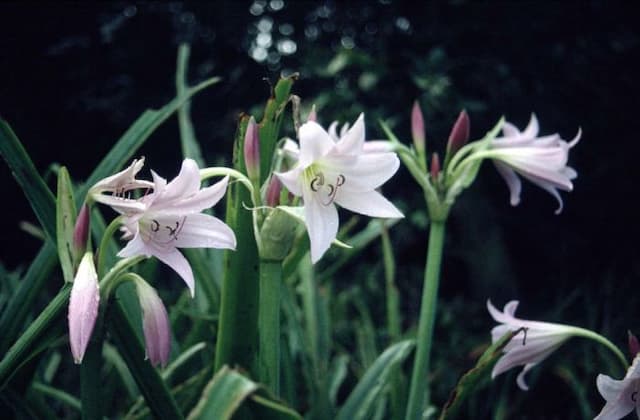Daffodil Narcissus 'Sint Victor' (1)

ABOUT
Narcissus 'Sint Victor' is a beautiful daffodil notable for its striking flowers. Each flower consists of predominantly white petals that radiate around a central cup. The cup is a contrasting, vivid orange color, adding to the dramatic display of the bloom. Typically, these daffodils display one flower per stem, giving a clean and focused look to each bloom. The foliage of 'Sint Victor' is a rich green, with slender, strap-like leaves that emerge from the base of the stem. These leaves provide a lush backdrop for the beautiful flowers, underlining their ornamental appeal. Overall, the contrast between the pristine white petals and the vibrant orange cup defines the captivating appearance of this plant, making it a popular choice for gardens and floral displays.
About this plant
 Names
NamesSynonyms
Daffodil, Narcissus, Jonquil.
Common names
Narcissus 'Sint Victor'.
 Toxicity
ToxicityTo humans
Daffodil is toxic to humans if ingested. All parts of the daffodil contain toxic alkaloids, including lycorine which can cause symptoms such as nausea, vomiting, abdominal pain, diarrhea, and can lead to more severe reactions such as cardiac arrhythmias or neurological issues in extreme cases.
To pets
Daffodil is also toxic to pets, with all parts of the plant being poisonous. Symptoms of poisoning in animals may include vomiting, salivation, diarrhea, convulsions, low blood pressure, tremors, and cardiac arrhythmias. If a pet ingests any part of the daffodil, it is advisable to seek veterinary attention immediately.
 Characteristics
CharacteristicsLife cycle
Perennials
Foliage type
Deciduous
Color of leaves
Green
Flower color
Yellow
Height
1-2 feet (30-60 cm)
Spread
1 feet (30 cm)
Plant type
Bulb
Hardiness zones
3-9
Native area
Europe
Benefits
 General Benefits
General Benefits- Aesthetic Appeal: The Narcissus 'Sint Victor', commonly known as daffodil, offers vibrant yellow blossoms that can brighten up any garden space.
- Easy to Grow: Daffodils are known for their ease of cultivation, requiring minimal care once established.
- Pest Resistance: These plants are relatively resistant to pests, making them a low-maintenance option for gardeners.
- Drought Tolerance: Once established, daffodils have moderate drought tolerance, making them suitable for a variety of climates.
- Symbolism and Tradition: Daffodils have long been associated with spring and renewal, making them a symbolic choice for gardens and gifts.
- Long Blooming Period: Daffodils typically have a generous blooming period, providing color and interest in the garden for an extended time.
- Naturalizing: Daffodils have the ability to naturalize, meaning they can spread and multiply, providing more blooms over time.
- Deer Resistance: Daffodils are usually not favored by deer, which makes them a good choice for areas where deer browsing is a problem.
 Medical Properties
Medical Properties- This plant is not used for medical purposes.
 Air-purifying Qualities
Air-purifying QualitiesThis plant is not specifically known for air purifying qualities.
 Other Uses
Other Uses- Floral Art: The distinctive appearance of the Narcissus 'Sint Victor' makes it an excellent choice for use in floral arrangements, adding a strong visual impact to the composition.
- Perfumery: Some narcissus varieties are used in perfumery for their sweet fragrance, though 'Sint Victor' may or may not be specifically used depending on its scent profile.
- Photography Props: Photographers might use Narcissus 'Sint Victor' as a subject in botanical photography due to its vibrant color and striking form.
- Natural Dyes: The petals of some narcissus flowers can be used to produce a yellow dye for fabrics, though this use depends on the color intensity of the particular variety.
- Garden Design: Narcissus 'Sint Victor' can be used as part of a color-themed garden to create striking visual displays during its blooming season.
- Education: These plants can be used in schools or educational programs to teach students about bulbous plant growth and reproduction.
- Eco-friendly Pest Control: Narcissus plants are known to repel certain pests, making them useful companions in gardens to help protect other plants without the use of chemicals.
- Crafts: Dried narcissus flowers can be incorporated into crafts, such as homemade potpourri mixes, for a natural touch and fragrance.
- Seasonal Celebrations: Narcissus 'Sint Victor' can be used to symbolize the arrival of spring in festivals and seasonal celebrations due to its early bloom.
- Memory Gardens: Planting Narcissus 'Sint Victor' can be a way to create a living memory or tribute to someone, as these flowers often symbolize rebirth and new beginnings.
Interesting Facts
 Feng Shui
Feng ShuiThe Daffodil is associated with good fortune and is believed to bring positive energy when placed in the wealth corner of a home, which is the southeast part of any room.
 Zodiac Sign Compitability
Zodiac Sign CompitabilityThe Daffodil is not used in astrology practice.
 Plant Symbolism
Plant Symbolism- Rebirth and New Beginnings: Narcissus blooms in early spring, making it a symbol of rebirth and the renewal that comes with the season.
- Self-love: Named after the Greek mythological character who fell in love with his own reflection, the Narcissus can represent narcissism or self-admiration.
- Hope: The hardiness and ability to rebloom are viewed as a sign of hope and enduring life.
- Wealth and Prosperity: In some cultures, the Narcissus is associated with good fortune and wealth, particularly when it blooms during the New Year celebrations.
- Vanity: Because of its association with the myth of Narcissus, this plant can sometimes represent vanity and excessive self-love.
 Water
WaterDaffodils, including the Narcissus 'Sint Victor', prefer consistent moisture during the growing season. Water the plant thoroughly when the top inch of the soil begins to dry out. Typically, this may be once a week, but you need to adjust according to weather conditions, more often during hot, dry spells, and less during cool, wet periods. A good rule of thumb is about one to one and a half gallons per square yard per week during active growth. Always avoid overwatering as daffodils are prone to bulb rot when kept too wet.
 Light
LightDaffodils, like Narcissus 'Sint Victor', thrive in full sunlight to partial shade. They perform best when they receive at least six hours of direct sunlight per day. Planting them in a spot that gets morning sunlight and some afternoon shade is ideal to protect them from the intense heat of the day.
 Temperature
TemperatureDaffodils, including Narcissus 'Sint Victor', can tolerate a wide temperature range but prefer a moderate climate. They are hardy in a range between 20°F and 70°F. The ideal temperature for promoting good growth and bloom is between 50°F and 65°F. Daffodils can tolerate brief periods of colder weather, but prolonged exposure to temperatures below the minimum can damage or kill the plants.
 Pruning
PruningPruning daffodils, including Narcissus 'Sint Victor', is not required for the health of the plant, but deadheading (removing spent flowers) can encourage the bulbs to store energy instead of producing seeds. Cut back the flower stalks after blooming, but allow the leaves to die back naturally for at least six weeks before removing, as they provide energy for next year's growth. Pruning is generally only recommended after the leaves yellow.
 Cleaning
CleaningAs needed
 Soil
SoilDaffodil 'Sint Victor' thrives in well-draining soil with moderate fertility and prefers a slightly acidic to neutral pH of 6.0 to 7.0. A mix of loamy soil with added organic matter like compost is ideal for optimal growth.
 Repotting
RepottingDaffodils, including 'Sint Victor', are generally repotted every 3 to 5 years or when the bulbs become overcrowded. The best time to repot is after the foliage has died back post-blooming.
 Humidity & Misting
Humidity & MistingDaffodil 'Sint Victor' tolerates typical outdoor humidity levels and does not require specific humidity adjustments when grown in natural outdoor conditions.
 Suitable locations
Suitable locationsIndoor
Place in bright, indirect light and provide cool temperatures.
Outdoor
Plant in well-draining soil with full or partial sun.
Hardiness zone
3-9 USDA.
 Life cycle
Life cycleNarcissus 'Saint Victor', commonly known as daffodil, begins its life cycle as a bulb, which lies dormant beneath the soil surface during the winter months. In early spring, environmental cues such as increasing temperatures and day length prompt the bulb to sprout, leading to the emergence of a shoot and leaves. The plant then develops one or several flower stalks, each bearing a single, showy flower, typically yellow or white with a trumpet-shaped corona, blooming from late winter to early spring. After flowering, the plant undergoes a period of photosynthesis and nutrient accumulation while the foliage is still green, storing energy back into the bulb for the next season. The leaves eventually yellow and die back as the plant enters a period of dormancy through the summer and autumn. Finally, the cycle repeats the following spring, with the bulb giving rise to new growth, continuing this yearly pattern of growth, flowering, and dormancy.
 Propogation
PropogationPropogation time
Spring-Early Summer
Propogation: The most popular method for propagating the Narcissus 'Sint Victor', commonly known as the daffodil, is through dividing and replanting the bulbs. This typically occurs in the late summer to early fall, once the foliage has died back and the plant is dormant. To propagate by division, carefully lift the bulb clumps from the ground with a gardening fork and gently separate the smaller, offset bulbs from the main bulb. Each offset should have a portion of the basal plate (bottom of the bulb) and some roots attached. These offsets can be replanted immediately at a depth about three times the height of the bulb, which is roughly 6 to 8 inches (15 to 20 centimeters), and spaced about 6 inches (15 centimeters) apart to give them room to grow. By the following spring, these offsets should have established themselves and will bloom, expanding the daffodil display in the garden.









